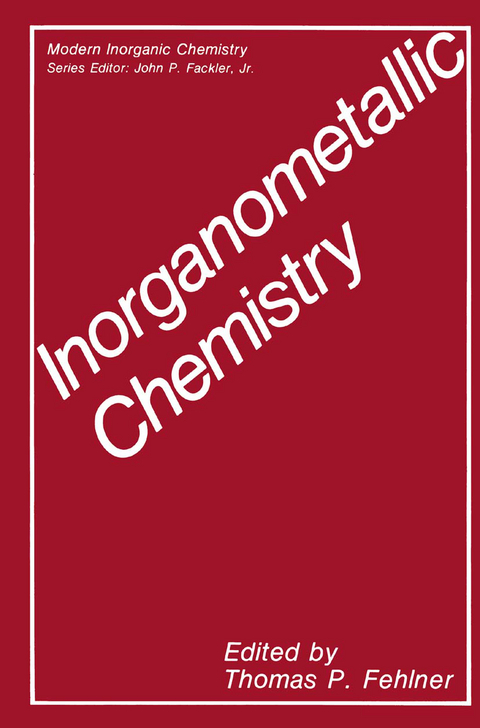
Inorganometallic Chemistry
Seiten
1992
Kluwer Academic/Plenum Publishers (Verlag)
978-0-306-43986-5 (ISBN)
Kluwer Academic/Plenum Publishers (Verlag)
978-0-306-43986-5 (ISBN)
There is a certain fascination associated with words. But language changes as old words are used in a new context and new words are created to describe changing situations. It is one created from old words to express a new presence.
There is a certain fascination associated with words. The manipulation of strings of symbols according to mutually accepted rules allows a language to express history as well as to formulate challenges for the future. But language changes as old words are used in a new context and new words are created to describe changing situations. How many words has the computer revolution alone added to languages? "Inorganometallic" is a word you probably have never encountered before. It is one created from old words to express a new presence. A strange sounding word, it is also a term fraught with internal contradiction caused by the accepted meanings of its constituent parts. "In organic" is the name of a discipline of chemistry while "metallic" refers to a set of elements constituting a subsection of that discipline. Why then this Carrollian approach to entitling a set of serious academic papers? Organic, the acknowledged doyenne of chemistry, is distinguished from her brother, inorganic, by the prefix "in," i. e. , he gets everything not organic. Organometallic refers to compounds with carbon-metal bonds. It is simple! Inorganometallic is everything else, i. e. , compounds with noncarbon-metal element bonds. But why a new term? Is not inorganic sufficient? By virtue of training, limited time, resources, co-workers, and so on, chemists tend to work on a specific element class, on a particular compound type, or in a particular phase. Thus, one finds element-oriented chemists (e. g.
There is a certain fascination associated with words. The manipulation of strings of symbols according to mutually accepted rules allows a language to express history as well as to formulate challenges for the future. But language changes as old words are used in a new context and new words are created to describe changing situations. How many words has the computer revolution alone added to languages? "Inorganometallic" is a word you probably have never encountered before. It is one created from old words to express a new presence. A strange sounding word, it is also a term fraught with internal contradiction caused by the accepted meanings of its constituent parts. "In organic" is the name of a discipline of chemistry while "metallic" refers to a set of elements constituting a subsection of that discipline. Why then this Carrollian approach to entitling a set of serious academic papers? Organic, the acknowledged doyenne of chemistry, is distinguished from her brother, inorganic, by the prefix "in," i. e. , he gets everything not organic. Organometallic refers to compounds with carbon-metal bonds. It is simple! Inorganometallic is everything else, i. e. , compounds with noncarbon-metal element bonds. But why a new term? Is not inorganic sufficient? By virtue of training, limited time, resources, co-workers, and so on, chemists tend to work on a specific element class, on a particular compound type, or in a particular phase. Thus, one finds element-oriented chemists (e. g.
1. Introduction.- 2. Main Group Fragments as Ligands to Transition Metals.- 3. Transition Metal-Main Group Cluster Compounds.- 4. Bonding Connections and Interrelationships.- 5. Experimental Comparison of the Bonding in Inorganometallic and Organometallic Complexes by Photoelectron Spectroscopy.- 6. Transition Metal-Promoted Reactions of Main Group Species and Main Group-Promoted Reactions of Transition Metal Species.- 7. The Metal-Nonmetal Bond in the Solid State.- 8. Molecular Precursors to Thin Films.- 9. Ceramics.
| Erscheint lt. Verlag | 30.6.1992 |
|---|---|
| Reihe/Serie | Modern Inorganic Chemistry |
| Zusatzinfo | XIV, 401 p. |
| Verlagsort | New York |
| Sprache | englisch |
| Maße | 155 x 235 mm |
| Themenwelt | Naturwissenschaften ► Chemie ► Analytische Chemie |
| Naturwissenschaften ► Chemie ► Anorganische Chemie | |
| Naturwissenschaften ► Physik / Astronomie ► Atom- / Kern- / Molekularphysik | |
| Naturwissenschaften ► Physik / Astronomie ► Festkörperphysik | |
| Technik ► Maschinenbau | |
| ISBN-10 | 0-306-43986-7 / 0306439867 |
| ISBN-13 | 978-0-306-43986-5 / 9780306439865 |
| Zustand | Neuware |
| Haben Sie eine Frage zum Produkt? |
Mehr entdecken
aus dem Bereich
aus dem Bereich


